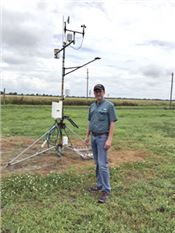|
Upgraded MU Weather Station Goes Online In Mississippi County

MU Extension agronomist Anthony Ohmes says the updated weather station in Mississippi County
will provide farmers and chemical applicators with real-time information to help them
avoid spraying during temperature inversions.
Photo courtesy of Anthony Ohmes.
CHARLESTON, MO.
A weather station in Mississippi County recently got an upgrade that lets it share real-time weather data.
The station, located 5 miles south of Charleston at the county airport, has been operational since 1995, says University of Missouri Extension climatologist Pat Guinan.
The station is part of the Missouri Mesonet, a network of 36 weather stations operated by MU Extension and the MU College of Agriculture, Food and Natural Resources.
MU Extension agronomist Anthony Ohmes and Missouri Mesonet co-manager John Travlos worked with Kevin Mainord of Aerial Crop Services of East Prairie to sponsor the station. “The station provided the opportunity for real-time upgrade and ensures sustainability,” says Travlos.
The Missouri Mesonet’s 36 stations are located in 25 counties across the state. The stations provide valuable information for agriculture, industry, commerce, public safety, education, research and more, Guinan says. Twenty-seven of the stations update and publish real-time weather data every five minutes.
The Charleston station records air temperature, rainfall, relative humidity, dew point temperature, wind speed, wind direction, 2- and 4-inch soil temperature, and solar radiation.
“Daily, hourly and year-to-date summaries of weather help farmers make decisions that affect their profitability,” says Ohmes, who works in MU Extension’s Cape Girardeau County office in Jackson. “The webpage also offers information on weather terminology,” he says.
The Charleston station is one of 12 stations to provide updates on the potential for temperature inversions, which are stable air masses in which air near the ground is cooler than the air above. This information can help farmers and chemical applicators know when to spray herbicides to avoid off-target movement. The station reads air temperatures at three ground heights. Reports feed to the Missouri Mesonet website at mesonet.missouri.edu.
The Missouri Soybean Merchandising Council funded updates for stations in Monroe City, Vandalia, Albany, Columbia, Green Ridge, Hayward, Lamar, Linneus and Mountain Grove to record the potential for temperature inversions.
For more information, visit AgEBB.missouri.edu/weather/stations or call 573-882-4827. ∆
|
|